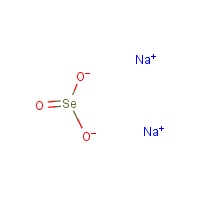Sodium selenite
Agent Name
Sodium selenite
CAS Number
10102-18-8
Formula
O3-Se.2Na
Major Category
Other Classes

Synonyms
Disodium selenite; Disodium selenium trioxide; Natriumselenit [German]; Selenious acid (H2SeO3), disodium salt; Selenious acid, disodium salt; Selenite sodium; [ChemIDplus] UN2630
Category
Other Inorganic Compounds
Description
Hygroscopic solid; [ICSC] White solid; [HSDB] Beige odorless crystalline powder; [MSDSonline]
Sources/Uses
Used as a colorant in glass production; [Kanerva, p. 1501] Used in glass manufacturing to remove green color, as an alkaloidal reagent, to test seed germination, as a reagent in bacteriology, for decorating porcelain, and as a dietary supplement; [HSDB]
Comments
Reported to be a skin sensitizer, but insufficient controls were tested; [Kanerva, p. 1499] Decomposed by flames and hot surfaces producing toxic gases; A skin, eye, and respiratory tract irritant; "The substance may cause effects on the liver, heart, nervous system, and gastrointestinal tract. The substance may have effects on the central nervous system, bone, and blood." [ICSC] Nontoxic when fed to hamsters at 10 ppm for 42 days; Histological changes in liver at 20 ppm (0.7 mg selenium/kg body weight/day); [HSDB] May cause skin, eye, and mucous membrane irritation; [CAMEO] An eye and mild skin irritant; May cause skin sensitization; [eChemPortal: ESIS] May cause irritation; May cause skin sensitization; [MSDSonline] Sodium selenite is "orders of magnitude more toxic than many other selenium compounds." [NIOSH IDLH Documentation] See "Selenium."
Biomedical References
Exposure Assessment
TLV (ACGIH)
0.2 mg/m3, as Se
PEL (OSHA)
0.2 mg/m3, as Se
MAK
0.02 mg/m3, as Se, inhalable fraction
IDLH (NIOSH)
1 mg/m3, as Se
Adverse Effects
Neurotoxin
Other CNS neurotoxin
Hepatotoxin
Hepatoxic (a) from occupational exposure (secondary effect) or (b) in animal studies or in humans after ingestion
Reproductive Toxin
Yes
Diseases, Processes, and Activities Linked to This Agent
Processes
Industrial Processes with risk of exposure:
Activities
Activities with risk of exposure: